SSC109e: Ageism, Workplace Discrimination, and Societal Impacts
VerifiedAdded on 2023/06/08
|9
|2240
|195
Essay
AI Summary
This essay delves into the multifaceted issue of ageism, examining its prevalence and impact within the workplace and broader society. It begins by defining ageism as discrimination based on age, particularly targeting older individuals, and explores the factors contributing to its persistence, including societal biases and perceptions of declining abilities. The essay then analyzes the negative consequences of ageism, such as reduced productivity, diminished mental health, and decreased self-esteem among older workers. It incorporates anthropological and sociological theories, such as sociocultural anthropology, physical anthropology, and functionalist theory, to provide a comprehensive understanding of the issue. Furthermore, the essay discusses the role of technology, corporate practices, and the pharmaceutical industry in perpetuating ageist attitudes. It concludes with recommendations for combating ageism, including promoting self-awareness, fostering intergenerational collaboration, and creating inclusive workplace environments. The essay underscores the need for organizations and individuals to recognize and address ageism to foster a more equitable and productive society.
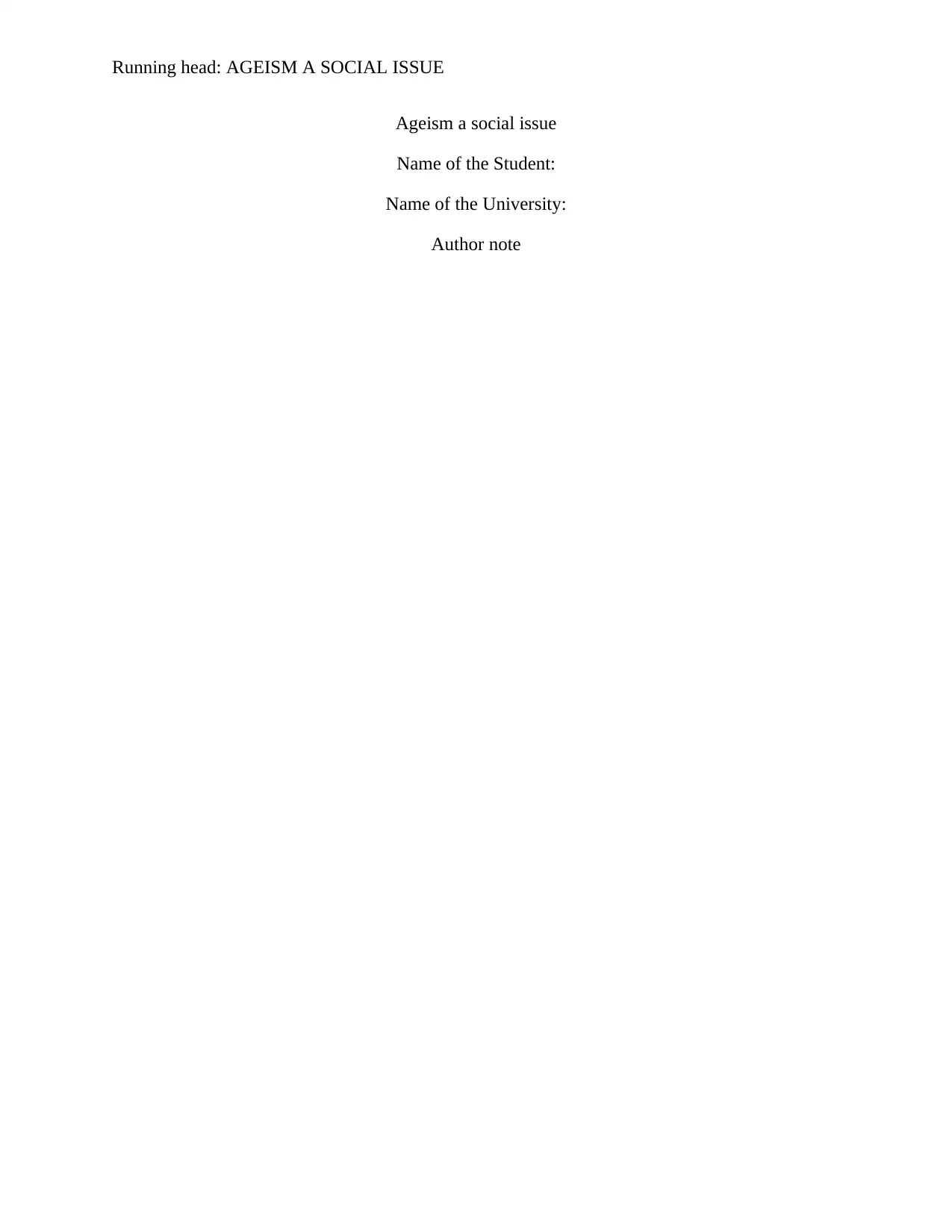
Running head: AGEISM A SOCIAL ISSUE
Ageism a social issue
Name of the Student:
Name of the University:
Author note
Ageism a social issue
Name of the Student:
Name of the University:
Author note
Paraphrase This Document
Need a fresh take? Get an instant paraphrase of this document with our AI Paraphraser
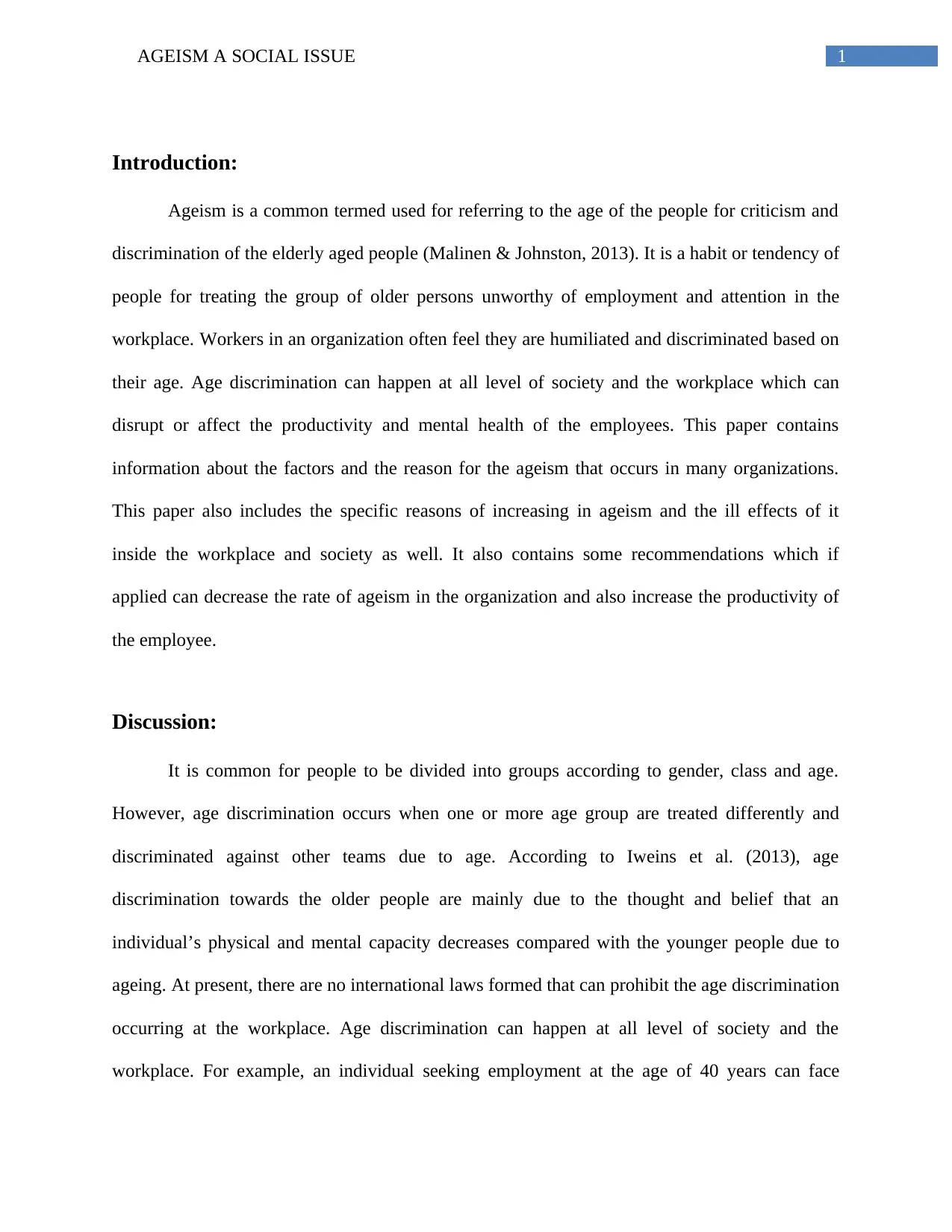
1AGEISM A SOCIAL ISSUE
Introduction:
Ageism is a common termed used for referring to the age of the people for criticism and
discrimination of the elderly aged people (Malinen & Johnston, 2013). It is a habit or tendency of
people for treating the group of older persons unworthy of employment and attention in the
workplace. Workers in an organization often feel they are humiliated and discriminated based on
their age. Age discrimination can happen at all level of society and the workplace which can
disrupt or affect the productivity and mental health of the employees. This paper contains
information about the factors and the reason for the ageism that occurs in many organizations.
This paper also includes the specific reasons of increasing in ageism and the ill effects of it
inside the workplace and society as well. It also contains some recommendations which if
applied can decrease the rate of ageism in the organization and also increase the productivity of
the employee.
Discussion:
It is common for people to be divided into groups according to gender, class and age.
However, age discrimination occurs when one or more age group are treated differently and
discriminated against other teams due to age. According to Iweins et al. (2013), age
discrimination towards the older people are mainly due to the thought and belief that an
individual’s physical and mental capacity decreases compared with the younger people due to
ageing. At present, there are no international laws formed that can prohibit the age discrimination
occurring at the workplace. Age discrimination can happen at all level of society and the
workplace. For example, an individual seeking employment at the age of 40 years can face
Introduction:
Ageism is a common termed used for referring to the age of the people for criticism and
discrimination of the elderly aged people (Malinen & Johnston, 2013). It is a habit or tendency of
people for treating the group of older persons unworthy of employment and attention in the
workplace. Workers in an organization often feel they are humiliated and discriminated based on
their age. Age discrimination can happen at all level of society and the workplace which can
disrupt or affect the productivity and mental health of the employees. This paper contains
information about the factors and the reason for the ageism that occurs in many organizations.
This paper also includes the specific reasons of increasing in ageism and the ill effects of it
inside the workplace and society as well. It also contains some recommendations which if
applied can decrease the rate of ageism in the organization and also increase the productivity of
the employee.
Discussion:
It is common for people to be divided into groups according to gender, class and age.
However, age discrimination occurs when one or more age group are treated differently and
discriminated against other teams due to age. According to Iweins et al. (2013), age
discrimination towards the older people are mainly due to the thought and belief that an
individual’s physical and mental capacity decreases compared with the younger people due to
ageing. At present, there are no international laws formed that can prohibit the age discrimination
occurring at the workplace. Age discrimination can happen at all level of society and the
workplace. For example, an individual seeking employment at the age of 40 years can face

2AGEISM A SOCIAL ISSUE
difficulties as they may often face interaction with younger employers who believe in ageism
(Kunze, Boehm & Bruch, 2013). Many negative attitudes and improper assumptions about
physical and mental ability are held responsible and can negatively reflect in attitudes and
metaphors of ageing. According to Allan, Johnson & Emerson (2014), the ageist based condition
in the workplace makes it more difficult for the employees for proper input in work and affect
the level of the output of the employee and also self-satisfaction is hampered. The ageism has
become a social and important issue to be discussed as it has become a global outcome and trend
in many organizations where ageism occurs internally. The two theories from anthropology
taken for the better understanding of the human behaviour and nature are Sociocultural
anthropology and Physical anthropology. Socio cultural anthropologists deal with the social
patterns of behaviour across different cultures and examine about people’s way of living and
communicating among others. The socio cultural behaviour has vital role in the pervasiveness of
ageism in the society and the workplace as well. The human behaviour among the society about
a certain group of people can influence other people to follow the same thought and belief. The
engagement of different kind of people and also the trend of groupism in the society and work
place gives a path to transfer thoughts and beliefs of an individual among other people of the
group. Their beliefs about the older employees include less hard working, less output, more
salary compared with other employees, less enthusiastic in taking risks and many more which
ultimately promotes the social issue of ageism among the people. Physical anthropology deals
with the physical aspects of an individual and also the factors affecting the wellness of a human
being. Ageism is the social issue that has been widely spreading across the world due to the
belief that physical and mental abilities in the work place goes down due to the age. People of
difficulties as they may often face interaction with younger employers who believe in ageism
(Kunze, Boehm & Bruch, 2013). Many negative attitudes and improper assumptions about
physical and mental ability are held responsible and can negatively reflect in attitudes and
metaphors of ageing. According to Allan, Johnson & Emerson (2014), the ageist based condition
in the workplace makes it more difficult for the employees for proper input in work and affect
the level of the output of the employee and also self-satisfaction is hampered. The ageism has
become a social and important issue to be discussed as it has become a global outcome and trend
in many organizations where ageism occurs internally. The two theories from anthropology
taken for the better understanding of the human behaviour and nature are Sociocultural
anthropology and Physical anthropology. Socio cultural anthropologists deal with the social
patterns of behaviour across different cultures and examine about people’s way of living and
communicating among others. The socio cultural behaviour has vital role in the pervasiveness of
ageism in the society and the workplace as well. The human behaviour among the society about
a certain group of people can influence other people to follow the same thought and belief. The
engagement of different kind of people and also the trend of groupism in the society and work
place gives a path to transfer thoughts and beliefs of an individual among other people of the
group. Their beliefs about the older employees include less hard working, less output, more
salary compared with other employees, less enthusiastic in taking risks and many more which
ultimately promotes the social issue of ageism among the people. Physical anthropology deals
with the physical aspects of an individual and also the factors affecting the wellness of a human
being. Ageism is the social issue that has been widely spreading across the world due to the
belief that physical and mental abilities in the work place goes down due to the age. People of
⊘ This is a preview!⊘
Do you want full access?
Subscribe today to unlock all pages.

Trusted by 1+ million students worldwide
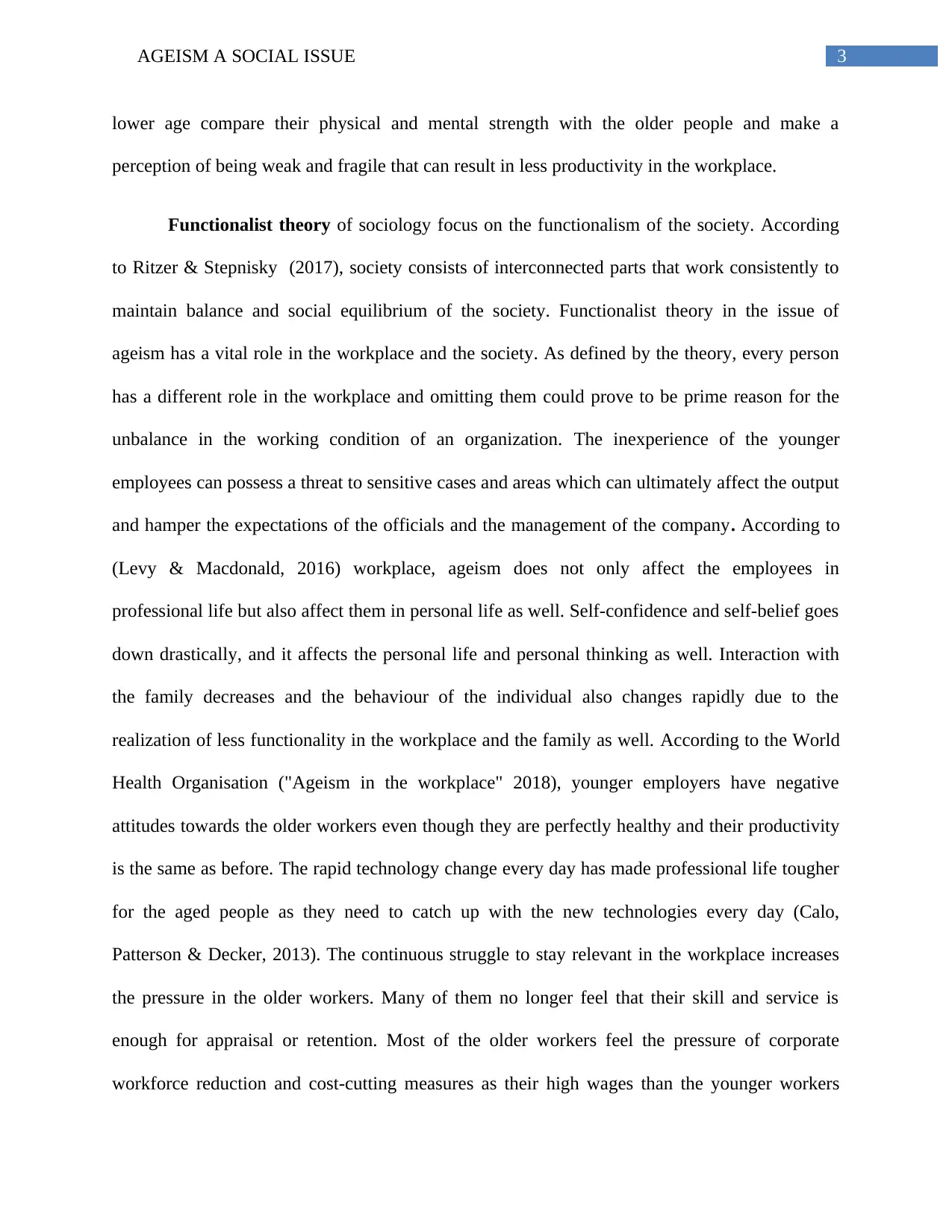
3AGEISM A SOCIAL ISSUE
lower age compare their physical and mental strength with the older people and make a
perception of being weak and fragile that can result in less productivity in the workplace.
Functionalist theory of sociology focus on the functionalism of the society. According
to Ritzer & Stepnisky (2017), society consists of interconnected parts that work consistently to
maintain balance and social equilibrium of the society. Functionalist theory in the issue of
ageism has a vital role in the workplace and the society. As defined by the theory, every person
has a different role in the workplace and omitting them could prove to be prime reason for the
unbalance in the working condition of an organization. The inexperience of the younger
employees can possess a threat to sensitive cases and areas which can ultimately affect the output
and hamper the expectations of the officials and the management of the company. According to
(Levy & Macdonald, 2016) workplace, ageism does not only affect the employees in
professional life but also affect them in personal life as well. Self-confidence and self-belief goes
down drastically, and it affects the personal life and personal thinking as well. Interaction with
the family decreases and the behaviour of the individual also changes rapidly due to the
realization of less functionality in the workplace and the family as well. According to the World
Health Organisation ("Ageism in the workplace" 2018), younger employers have negative
attitudes towards the older workers even though they are perfectly healthy and their productivity
is the same as before. The rapid technology change every day has made professional life tougher
for the aged people as they need to catch up with the new technologies every day (Calo,
Patterson & Decker, 2013). The continuous struggle to stay relevant in the workplace increases
the pressure in the older workers. Many of them no longer feel that their skill and service is
enough for appraisal or retention. Most of the older workers feel the pressure of corporate
workforce reduction and cost-cutting measures as their high wages than the younger workers
lower age compare their physical and mental strength with the older people and make a
perception of being weak and fragile that can result in less productivity in the workplace.
Functionalist theory of sociology focus on the functionalism of the society. According
to Ritzer & Stepnisky (2017), society consists of interconnected parts that work consistently to
maintain balance and social equilibrium of the society. Functionalist theory in the issue of
ageism has a vital role in the workplace and the society. As defined by the theory, every person
has a different role in the workplace and omitting them could prove to be prime reason for the
unbalance in the working condition of an organization. The inexperience of the younger
employees can possess a threat to sensitive cases and areas which can ultimately affect the output
and hamper the expectations of the officials and the management of the company. According to
(Levy & Macdonald, 2016) workplace, ageism does not only affect the employees in
professional life but also affect them in personal life as well. Self-confidence and self-belief goes
down drastically, and it affects the personal life and personal thinking as well. Interaction with
the family decreases and the behaviour of the individual also changes rapidly due to the
realization of less functionality in the workplace and the family as well. According to the World
Health Organisation ("Ageism in the workplace" 2018), younger employers have negative
attitudes towards the older workers even though they are perfectly healthy and their productivity
is the same as before. The rapid technology change every day has made professional life tougher
for the aged people as they need to catch up with the new technologies every day (Calo,
Patterson & Decker, 2013). The continuous struggle to stay relevant in the workplace increases
the pressure in the older workers. Many of them no longer feel that their skill and service is
enough for appraisal or retention. Most of the older workers feel the pressure of corporate
workforce reduction and cost-cutting measures as their high wages than the younger workers
Paraphrase This Document
Need a fresh take? Get an instant paraphrase of this document with our AI Paraphraser
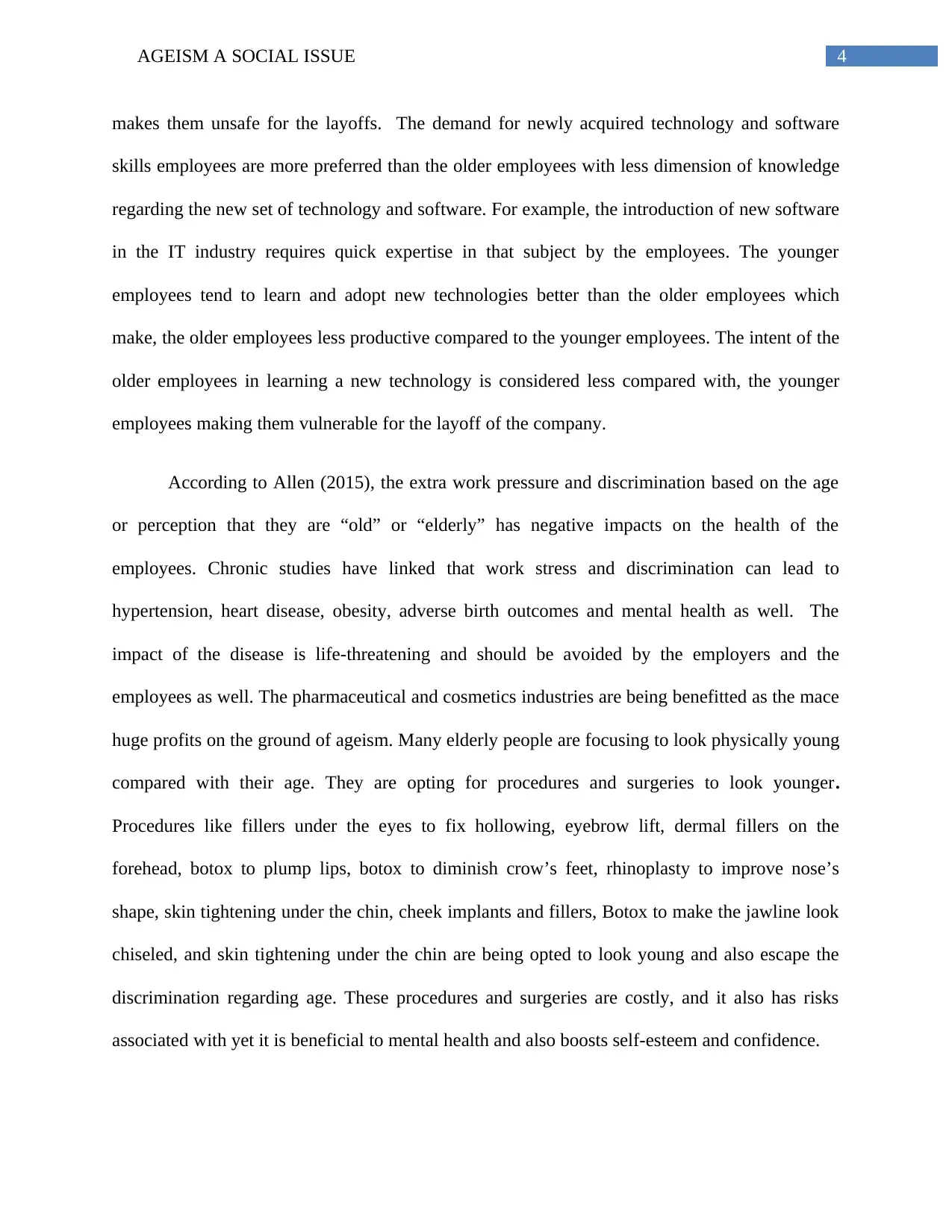
4AGEISM A SOCIAL ISSUE
makes them unsafe for the layoffs. The demand for newly acquired technology and software
skills employees are more preferred than the older employees with less dimension of knowledge
regarding the new set of technology and software. For example, the introduction of new software
in the IT industry requires quick expertise in that subject by the employees. The younger
employees tend to learn and adopt new technologies better than the older employees which
make, the older employees less productive compared to the younger employees. The intent of the
older employees in learning a new technology is considered less compared with, the younger
employees making them vulnerable for the layoff of the company.
According to Allen (2015), the extra work pressure and discrimination based on the age
or perception that they are “old” or “elderly” has negative impacts on the health of the
employees. Chronic studies have linked that work stress and discrimination can lead to
hypertension, heart disease, obesity, adverse birth outcomes and mental health as well. The
impact of the disease is life-threatening and should be avoided by the employers and the
employees as well. The pharmaceutical and cosmetics industries are being benefitted as the mace
huge profits on the ground of ageism. Many elderly people are focusing to look physically young
compared with their age. They are opting for procedures and surgeries to look younger.
Procedures like fillers under the eyes to fix hollowing, eyebrow lift, dermal fillers on the
forehead, botox to plump lips, botox to diminish crow’s feet, rhinoplasty to improve nose’s
shape, skin tightening under the chin, cheek implants and fillers, Botox to make the jawline look
chiseled, and skin tightening under the chin are being opted to look young and also escape the
discrimination regarding age. These procedures and surgeries are costly, and it also has risks
associated with yet it is beneficial to mental health and also boosts self-esteem and confidence.
makes them unsafe for the layoffs. The demand for newly acquired technology and software
skills employees are more preferred than the older employees with less dimension of knowledge
regarding the new set of technology and software. For example, the introduction of new software
in the IT industry requires quick expertise in that subject by the employees. The younger
employees tend to learn and adopt new technologies better than the older employees which
make, the older employees less productive compared to the younger employees. The intent of the
older employees in learning a new technology is considered less compared with, the younger
employees making them vulnerable for the layoff of the company.
According to Allen (2015), the extra work pressure and discrimination based on the age
or perception that they are “old” or “elderly” has negative impacts on the health of the
employees. Chronic studies have linked that work stress and discrimination can lead to
hypertension, heart disease, obesity, adverse birth outcomes and mental health as well. The
impact of the disease is life-threatening and should be avoided by the employers and the
employees as well. The pharmaceutical and cosmetics industries are being benefitted as the mace
huge profits on the ground of ageism. Many elderly people are focusing to look physically young
compared with their age. They are opting for procedures and surgeries to look younger.
Procedures like fillers under the eyes to fix hollowing, eyebrow lift, dermal fillers on the
forehead, botox to plump lips, botox to diminish crow’s feet, rhinoplasty to improve nose’s
shape, skin tightening under the chin, cheek implants and fillers, Botox to make the jawline look
chiseled, and skin tightening under the chin are being opted to look young and also escape the
discrimination regarding age. These procedures and surgeries are costly, and it also has risks
associated with yet it is beneficial to mental health and also boosts self-esteem and confidence.
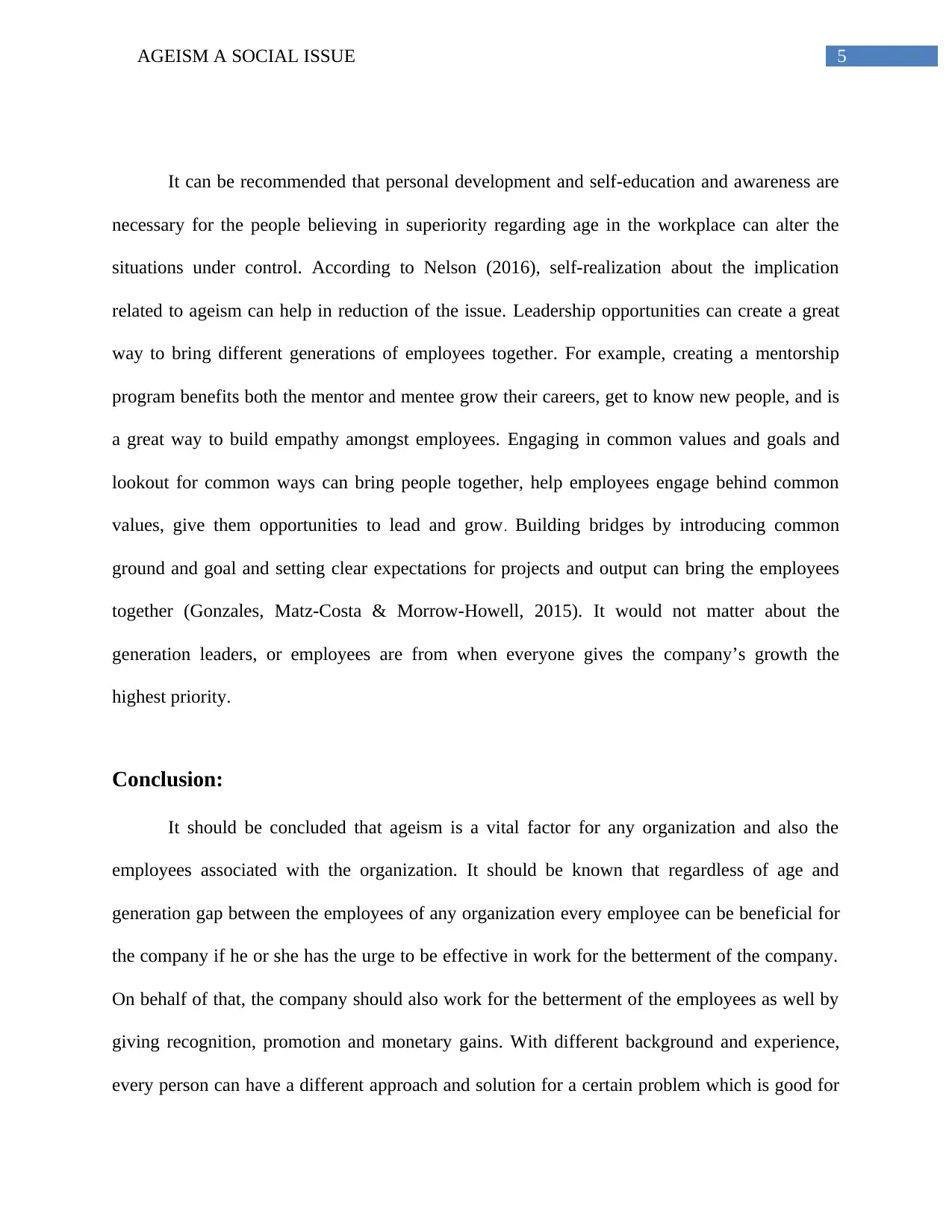
5AGEISM A SOCIAL ISSUE
It can be recommended that personal development and self-education and awareness are
necessary for the people believing in superiority regarding age in the workplace can alter the
situations under control. According to Nelson (2016), self-realization about the implication
related to ageism can help in reduction of the issue. Leadership opportunities can create a great
way to bring different generations of employees together. For example, creating a mentorship
program benefits both the mentor and mentee grow their careers, get to know new people, and is
a great way to build empathy amongst employees. Engaging in common values and goals and
lookout for common ways can bring people together, help employees engage behind common
values, give them opportunities to lead and grow. Building bridges by introducing common
ground and goal and setting clear expectations for projects and output can bring the employees
together (Gonzales, Matz-Costa & Morrow-Howell, 2015). It would not matter about the
generation leaders, or employees are from when everyone gives the company’s growth the
highest priority.
Conclusion:
It should be concluded that ageism is a vital factor for any organization and also the
employees associated with the organization. It should be known that regardless of age and
generation gap between the employees of any organization every employee can be beneficial for
the company if he or she has the urge to be effective in work for the betterment of the company.
On behalf of that, the company should also work for the betterment of the employees as well by
giving recognition, promotion and monetary gains. With different background and experience,
every person can have a different approach and solution for a certain problem which is good for
It can be recommended that personal development and self-education and awareness are
necessary for the people believing in superiority regarding age in the workplace can alter the
situations under control. According to Nelson (2016), self-realization about the implication
related to ageism can help in reduction of the issue. Leadership opportunities can create a great
way to bring different generations of employees together. For example, creating a mentorship
program benefits both the mentor and mentee grow their careers, get to know new people, and is
a great way to build empathy amongst employees. Engaging in common values and goals and
lookout for common ways can bring people together, help employees engage behind common
values, give them opportunities to lead and grow. Building bridges by introducing common
ground and goal and setting clear expectations for projects and output can bring the employees
together (Gonzales, Matz-Costa & Morrow-Howell, 2015). It would not matter about the
generation leaders, or employees are from when everyone gives the company’s growth the
highest priority.
Conclusion:
It should be concluded that ageism is a vital factor for any organization and also the
employees associated with the organization. It should be known that regardless of age and
generation gap between the employees of any organization every employee can be beneficial for
the company if he or she has the urge to be effective in work for the betterment of the company.
On behalf of that, the company should also work for the betterment of the employees as well by
giving recognition, promotion and monetary gains. With different background and experience,
every person can have a different approach and solution for a certain problem which is good for
⊘ This is a preview!⊘
Do you want full access?
Subscribe today to unlock all pages.

Trusted by 1+ million students worldwide

6AGEISM A SOCIAL ISSUE
the company to be able to choose the best solution from many. In short blending different
generational groups in a workplace can be beneficial for the company if it can be managed in a
strategic and expressive way. Ageism has mostly negative impacts on the employees both
mentally and professionally which if not avoided can fatal for the employees regarding the
mental and physical health of the affected employees.
the company to be able to choose the best solution from many. In short blending different
generational groups in a workplace can be beneficial for the company if it can be managed in a
strategic and expressive way. Ageism has mostly negative impacts on the employees both
mentally and professionally which if not avoided can fatal for the employees regarding the
mental and physical health of the affected employees.
Paraphrase This Document
Need a fresh take? Get an instant paraphrase of this document with our AI Paraphraser
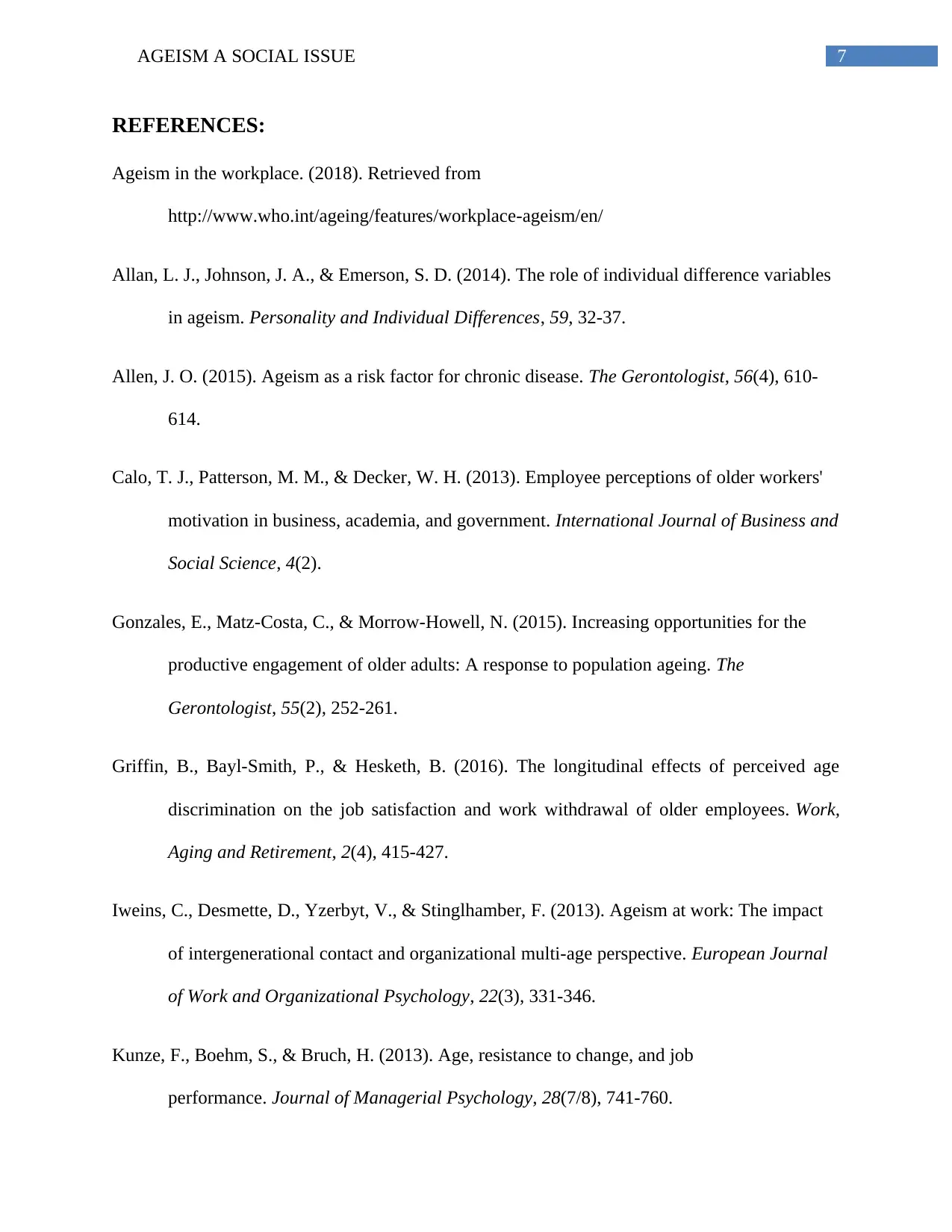
7AGEISM A SOCIAL ISSUE
REFERENCES:
Ageism in the workplace. (2018). Retrieved from
http://www.who.int/ageing/features/workplace-ageism/en/
Allan, L. J., Johnson, J. A., & Emerson, S. D. (2014). The role of individual difference variables
in ageism. Personality and Individual Differences, 59, 32-37.
Allen, J. O. (2015). Ageism as a risk factor for chronic disease. The Gerontologist, 56(4), 610-
614.
Calo, T. J., Patterson, M. M., & Decker, W. H. (2013). Employee perceptions of older workers'
motivation in business, academia, and government. International Journal of Business and
Social Science, 4(2).
Gonzales, E., Matz-Costa, C., & Morrow-Howell, N. (2015). Increasing opportunities for the
productive engagement of older adults: A response to population ageing. The
Gerontologist, 55(2), 252-261.
Griffin, B., Bayl-Smith, P., & Hesketh, B. (2016). The longitudinal effects of perceived age
discrimination on the job satisfaction and work withdrawal of older employees. Work,
Aging and Retirement, 2(4), 415-427.
Iweins, C., Desmette, D., Yzerbyt, V., & Stinglhamber, F. (2013). Ageism at work: The impact
of intergenerational contact and organizational multi-age perspective. European Journal
of Work and Organizational Psychology, 22(3), 331-346.
Kunze, F., Boehm, S., & Bruch, H. (2013). Age, resistance to change, and job
performance. Journal of Managerial Psychology, 28(7/8), 741-760.
REFERENCES:
Ageism in the workplace. (2018). Retrieved from
http://www.who.int/ageing/features/workplace-ageism/en/
Allan, L. J., Johnson, J. A., & Emerson, S. D. (2014). The role of individual difference variables
in ageism. Personality and Individual Differences, 59, 32-37.
Allen, J. O. (2015). Ageism as a risk factor for chronic disease. The Gerontologist, 56(4), 610-
614.
Calo, T. J., Patterson, M. M., & Decker, W. H. (2013). Employee perceptions of older workers'
motivation in business, academia, and government. International Journal of Business and
Social Science, 4(2).
Gonzales, E., Matz-Costa, C., & Morrow-Howell, N. (2015). Increasing opportunities for the
productive engagement of older adults: A response to population ageing. The
Gerontologist, 55(2), 252-261.
Griffin, B., Bayl-Smith, P., & Hesketh, B. (2016). The longitudinal effects of perceived age
discrimination on the job satisfaction and work withdrawal of older employees. Work,
Aging and Retirement, 2(4), 415-427.
Iweins, C., Desmette, D., Yzerbyt, V., & Stinglhamber, F. (2013). Ageism at work: The impact
of intergenerational contact and organizational multi-age perspective. European Journal
of Work and Organizational Psychology, 22(3), 331-346.
Kunze, F., Boehm, S., & Bruch, H. (2013). Age, resistance to change, and job
performance. Journal of Managerial Psychology, 28(7/8), 741-760.
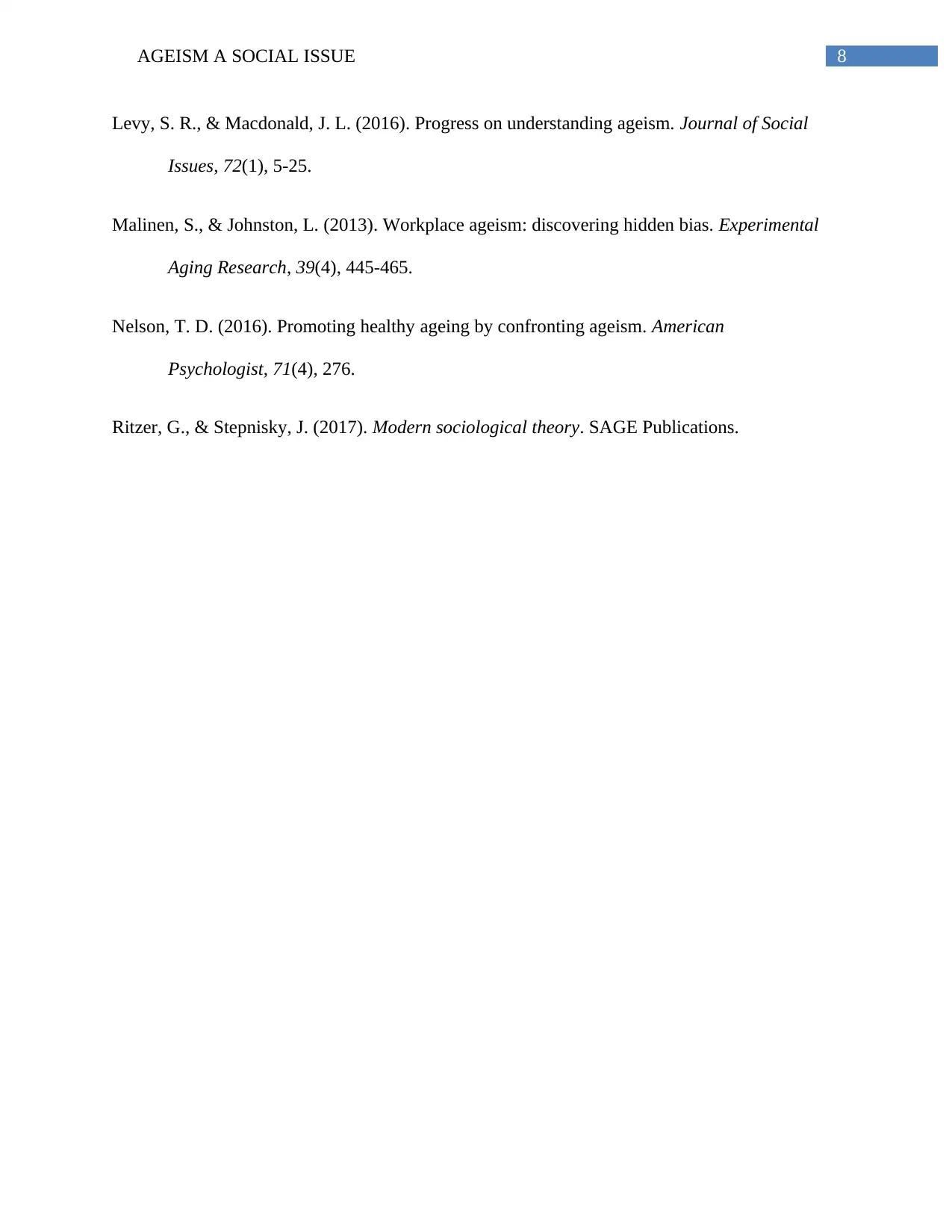
8AGEISM A SOCIAL ISSUE
Levy, S. R., & Macdonald, J. L. (2016). Progress on understanding ageism. Journal of Social
Issues, 72(1), 5-25.
Malinen, S., & Johnston, L. (2013). Workplace ageism: discovering hidden bias. Experimental
Aging Research, 39(4), 445-465.
Nelson, T. D. (2016). Promoting healthy ageing by confronting ageism. American
Psychologist, 71(4), 276.
Ritzer, G., & Stepnisky, J. (2017). Modern sociological theory. SAGE Publications.
Levy, S. R., & Macdonald, J. L. (2016). Progress on understanding ageism. Journal of Social
Issues, 72(1), 5-25.
Malinen, S., & Johnston, L. (2013). Workplace ageism: discovering hidden bias. Experimental
Aging Research, 39(4), 445-465.
Nelson, T. D. (2016). Promoting healthy ageing by confronting ageism. American
Psychologist, 71(4), 276.
Ritzer, G., & Stepnisky, J. (2017). Modern sociological theory. SAGE Publications.
⊘ This is a preview!⊘
Do you want full access?
Subscribe today to unlock all pages.

Trusted by 1+ million students worldwide
1 out of 9
Related Documents
Your All-in-One AI-Powered Toolkit for Academic Success.
+13062052269
info@desklib.com
Available 24*7 on WhatsApp / Email
![[object Object]](/_next/static/media/star-bottom.7253800d.svg)
Unlock your academic potential
Copyright © 2020–2025 A2Z Services. All Rights Reserved. Developed and managed by ZUCOL.





